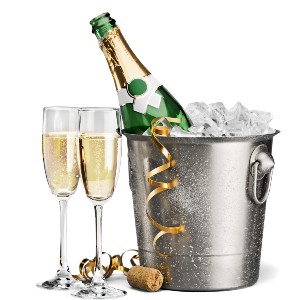Every wine has a unique story to tell, with specific characteristics designed to impress. However, the temperature at which wine is served can greatly affect its flavor profile. Proper serving temperatures allow each element to layer on the palate with precision, creating a truly enjoyable experience.
Negative Effects Of Improper Wine Drinking Temperatures
Wine served too cool it will exhibit restricted aromas and flavors. It will lack overall complexity and may even taste sour.
Aromas in wines that are served too warm may burn your nose or have medicinal qualities. This is a common problem seen in wine with high alcohol content. Tannic red wines when served too warm may have tannins that appear too loose, becoming alcoholic and oftentimes flabby.
When serving a wine I often tend to chill it to slightly cooler than the optimal drinking temperature. Once the wine is poured into your glass its temperature will increase by a few degrees fairly quickly.
Optimal Wine Drinking Temperatures
Champagne & Sparkling Wines

Ice cold, somewhere between 42 to 55°F (5.5 to 10°C).
With sparkling wines, it is crucial that you pay attention to the temperature you are serving your wine. If you try and open a bottle of bubbles while it is still warm the pressure will push the cork out too quickly. The result can be anywhere from a cork taking out your eye to losing a good portion of your wine as it spills uncontrollably from the bottle.
Chilling your bottle to as low as 38°F (3°C) is a great rule of thumb. Don’t chill your bubbles in the freezer, this outcome could be catastrophic, killing the bubbles. If you are in a rush you can chill your bottle in an ice bath with the addition of a spoonful of salt. The salt will help to accelerate the chilling time.
Light White Wine & Sweet White Wine

Ice cold, somewhere between 42 to 55°F (5.5 to 10°C).
These wines will often have more refined characteristics. Serving a sweeter wine at a cooler temp will help to bring forward the acid in the wine, balancing the sweetness.
Rosé

Cold, between 45 to 55°F (7 to 13°C).
This can be more of a preference thing. For myself, I like to enjoy my first glass on the colder side. I will usually choose to then leave the bottle out, letting it reach up to 60°F (15.5°C). When drinking a dry Rosé I will keep it chilled on the cold side.
Full-Bodied Whites & Light-Bodied Reds

Between 50 to 62°F (10 to 15°C).
It is a common mistake to serve full-bodied white wines at too cool of a temperature. This will restrict flavors in the wine, keeping you from experiencing the wine’s full expression.
Characterized by their more refined nuances on the palate, a lighter red, like Pinot Noir, should be enjoyed at a cooler temperature. This will prevent the alcohol from dominating the other flavors.
Medium-Bodied Red Wines

Between 55 to 62°F (13 to 17°C).
This temperature will keep your wine from becoming too “hot” (alcoholic) while allowing you to still evaluate all of the flavor complexities layered throughout.
Full-Bodied Red Wines

Between 58 to 65°F (14.5 to 18°C).
You will often see this referred to as room temperature. It is important to note that this temperature is often cooler than most of us keep our own homes. This temperature will allow for a lush mouthfeel, balanced acidity, and well-rounded tannins.
Fortified Wine Drinking Temperatures

Dry Sherry and Dry Madeira should be served slightly cooler than other examples of fortified wines. Between 48 to 55°F (9 to 13°C) is optimal.
Sweet Sherry and Madeira as well as Tawny as Vintage Port is best enjoyed between 55 to 62°F (13 to 17°C).
Want to learn more about the effect temperature plays of your wine? Check out my article on wine storage and bottle aging.